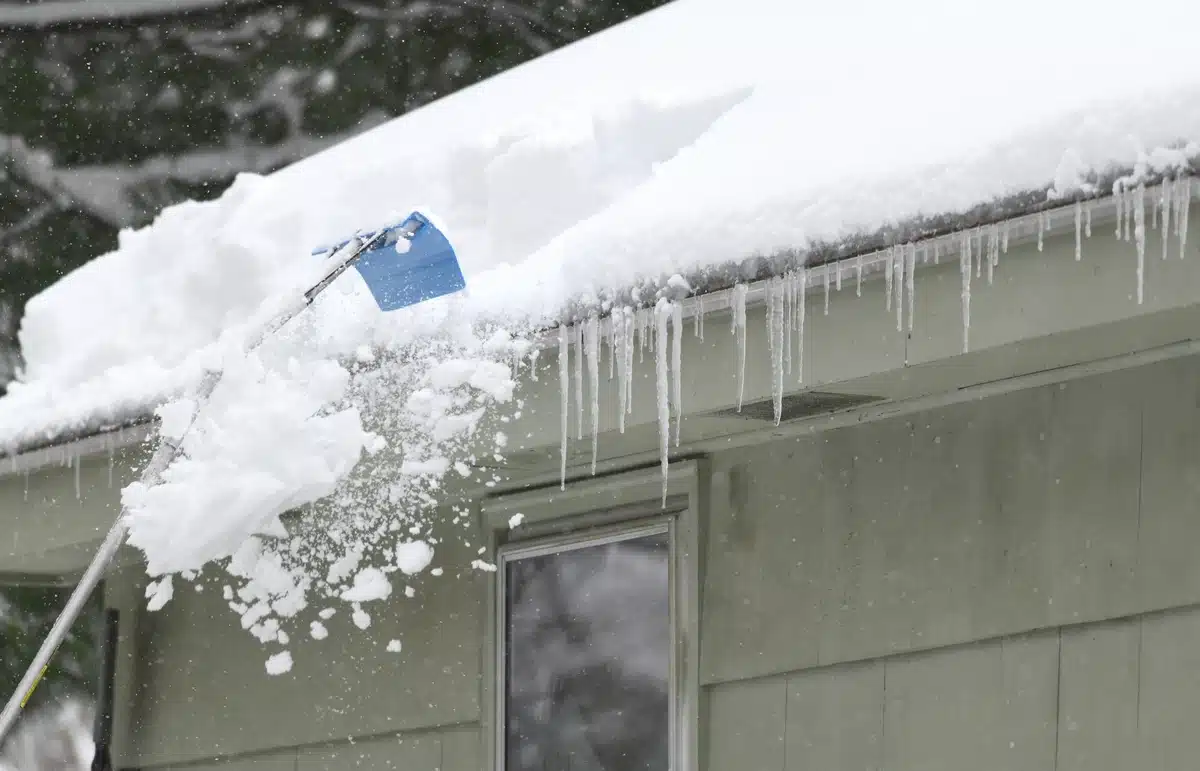Roof Snow Removal
Table of Contents
As winter approaches, the charm of snow-covered landscapes can quickly turn into a concern for homeowners, particularly when it comes to the weight of snow accumulating on their roofs.
While a picturesque blanket of snow on your roof may seem harmless, the reality is that it can pose significant risks to both your roof’s integrity and your family’s safety. That’s why we’re here to help you understand:
- The importance of roof snow removal
- The potential dangers of snow buildup
- Safe snow removal techniques
- When to seek professional assistance
- Associated costs
- Essential tips for preparing your roof for winter

How Much Snow Can a Roof Hold?
Understanding the weight-bearing capacity of your roof is crucial for determining when it’s time for roof snow remove. The amount of snow a roof can support varies depending on factors such as the roof’s design, materials, age, and structural integrity. However, a general rule of thumb is that most roofs can safely withstand about 20 to 25 pounds per square foot of snow load.
It’s essential to monitor snow accumulation, especially during heavy snowfall or wet snow conditions, which can significantly increase the weight on your roof. Exceeding the recommended weight limit can lead to structural damage, including roof collapse, making roof snow removing an absolute necessity.
The Dangers of Snow Piling Up on Your Roof
Allowing snow to accumulate on your roof can pose various hazards, both immediate and long-term. Some of the potential dangers include:
Roof Collapse
The most severe consequence of excessive snow buildup is the risk of roof collapse. This risk emphasizes the importance of timely roof snow removal to prevent such catastrophic failures.
Ice Dams
Snow accumulation on the roof can melt and refreeze near the edges, creating ice dams. These prevent proper drainage, causing water to seep under shingles and into the attic. Proper roof snow removing can help mitigate ice dam formation.
Gutters and Downspouts Damage
Heavy snow and ice can damage gutters and downspouts, leading to clogs and drainage issues. Blocked gutters can cause water overflow, which is why roof snow removing is essential for protecting your home’s infrastructure.
Falling Ice and Snow
As temperatures fluctuate, snow and ice can slide off the roof, posing a hazard to people and property below. Effective roof snow removal can prevent such accidents.

How to Safely Remove Snow from Your Roof: 5 Steps
When it comes to roof snow removal, safety should always be the top priority. Here are some essential tips for safely clearing snow from your roof:
- Use the Right Tools:
Invest in a sturdy roof rake with a telescoping handle for roof snow removed from the ground. Avoid using metal tools that could damage shingles or gutters. - Work from the Ground:
Whenever possible, remove snow from the ground using a roof rake. This technique minimizes risks associated with climbing onto the roof for roof snow removal. - Clear Snow Regularly:
Monitor snow accumulation and remove it promptly to prevent excessive buildup. Regular roof snow removal reduces the risk of structural damage and ice dam formation. - Start from the Edges:
Begin your roof snow removal efforts by clearing snow from the edges and gutters to allow proper drainage. Work your way toward the roof’s center. - Beware of Falling Snow:
Stand clear of the roof’s edge during roof snow removal to avoid injury from falling snow or ice.
When to Hire a Professional
While DIY roof snow removal is feasible in some cases, certain situations call for professional assistance:
- Steep or High Roofs: Professionals have the expertise and tools needed for safe roof snow removal on challenging roof structures.
- Excessive Snow Accumulation: Large amounts of snow require specialized techniques for effective roof snow removal.
- Time Constraints or Safety Concerns: If you’re unable to dedicate time or safely perform roof snow removal, hire a professional.
The Cost of Professional Roof Snow Removal
The cost of professional roof snow removal services varies based on factors like roof size, snow amount, and accessibility. On average, homeowners can expect to pay between $200 and $600 for professional roof snow removal.

How to Prep Your Roof for Winter Time
Proper preparation minimizes the need for frequent roof snow removal and protects your roof during winter storms:
- Inspect and Repair: Address any damage to ensure your roof is ready for snow.
- Clean Gutters: Prevent ice dams by keeping gutters clear.
- Reinforce Insulation: Proper attic insulation reduces heat loss, preventing ice dams and easing roof snow.
Prevent Ice Dams With Tectum!
Snow removal is a critical aspect of winter home maintenance. By understanding the risks of snow buildup and adopting safe roof snow removal techniques, you can protect your home and family.
Are you ready to ensure your roof is safe and secure this winter? Tectum Roofing specializes in professional roof snow removal services to keep your home protected. Contact us today!



